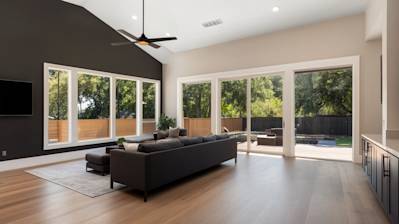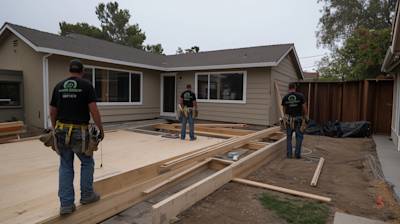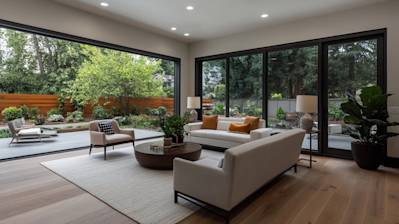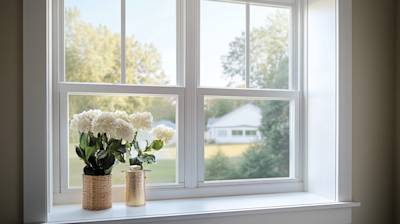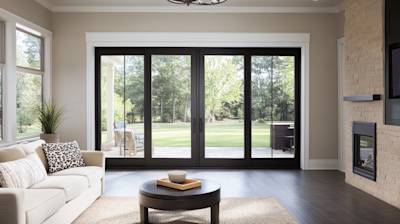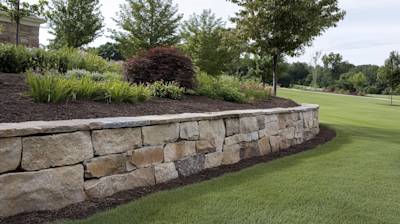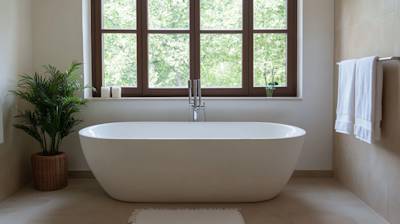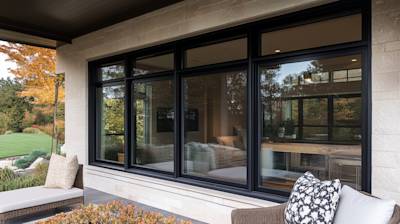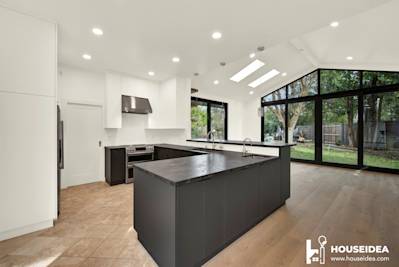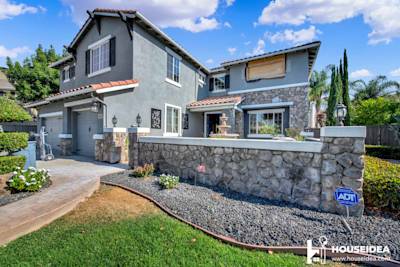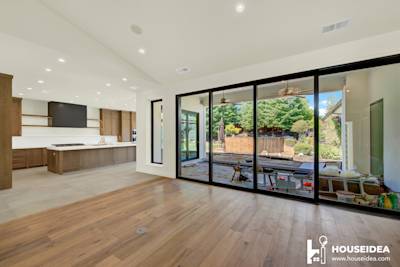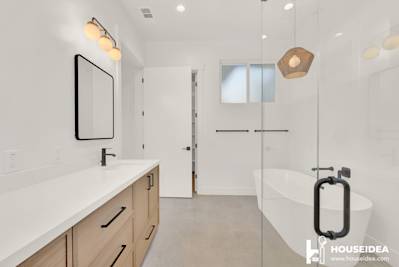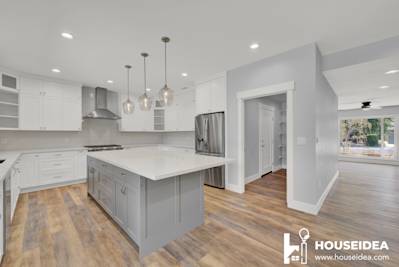When it comes to construction and landscaping, professionals often need to deal with a variety of challenges related to terrain and soil structure. We often need to create safe and long-lasting structures in areas with sloping or uneven terrain. This is where the concept of wall retention or retaining walls comes into the picture. Utilizing wall retention techniques, builders ensure safety and stability. In today's blog, we will delve deeper into the fundamentals of wall retention.
What is Wall Retention?
Wall retention, also known as a retaining wall, is a structure designed and constructed to resist the lateral pressure of soil, especially when a change in ground elevation exceeds the angle of repose of the soil.
A retaining wall does more than just hold back soil. It transforms your landscape, enhances your property value, and can even serve for practical purposes such as preventing erosion or water damage.
Structural Design of Retaining Walls
Retaining walls are designed to interact with the soil mass, and they must be sturdy enough to withstand the weight and pressure exerted by the soil. Here are the essential components that go into the construction of these walls:
- Retaining Wall Footings – These provide the base for the retaining wall.
- Stem of Retaining Wall - This is the main visible part of the wall and is usually designed to be both strong and aesthetically pleasing.
- Retaining Wall Cap - This forms the 'top' of the wall, helping to protect the structure underneath.
- Weep Hole - This is designed into the wall to allow water to escape, thus reducing hydraulic pressure on the wall.
Different Types of Retaining Walls
There are several types of retaining walls that can be used, each with their unique characteristics.
- Gravity Retaining Wall - these utilize their weight to resist the pressure from the soil behind the wall.
- Cantilevered Retaining Wall - these make use of a form of lever arm to manage the lateral pressure of the soil.
- Sheet Piling Retaining Wall - typically used in tight areas with soft soil, these walls are usually made out of steel, vinyl, or wood planks.
- Anchored Retaining Wall - these include additional strength elements (anchors) that are driven deep into the ground to resist higher loads.
The Role of Backfill in Wall Retention
The process of wall retention doesn’t stop with the wall itself. The material that supports this structure from behind is known as backfill. Backfill plays a crucial role in wall retention by supporting the structure and also facilitating drainage to reduce hydrostatic pressure. There are various types of backfill material, such as:
- Gravel
- Sand
- Topsoil
- Original soil
Choice of backfill is often vital to ensure longevity and optimal functioning of the retaining wall.
Building a Retaining Wall
Constructing a retaining wall is a detailed process that requires careful planning and execution. Here are the basic steps involved:
- Planning and Design: Evaluate the area where the wall will be built, decide on the type of wall, and create a design.
- Excavation: Remove soil and level the ground in the area where the wall will be located.
- Foundation Preparation: Lay down the foundation, usually made up of concrete.
- Wall Construction: Build the wall from your chosen materials, layer by layer.
- Backfill and Compaction: Add and compact backfill behind your wall.
Frequently Asked Questions about Wall Retention
What are the different types of wall retention systems available?
There are various types of wall retention systems on the market, including concrete walls, retaining wall blocks, gabion walls, sheet pile walls, soldier pile walls, soil nailing, and anchored walls. The most suitable choice will depend on factors such as site conditions, soil type, environmental impact, and budget.
How does soil type impact the choice of wall retention system?
Different soil types respond in different ways to stress and load, so it's crucial to understand the soil type in your specific location. For instance, sandy or silty soils may require a deeply embedded wall retention system due to poor cohesion. Alternatively, clay soils may need quality drainage mechanisms incorporated to mitigate water-related issues.
What factors should be considered when designing a wall retention system?
Designing a wall retention system involves contemplating various elements like soil conditions, loading conditions, ground water table, aesthetic appearance, local building codes, environmental impact, project time frames, and cost. It's a meticulous planning process that ideally involves the expertise of a certified engineer.
Does wall retention require maintenance?
Yes, checks and maintenance are essential to a wall retention system's life cycle. Regular inspections can help identify any areas that need repair. For subsurface drainage systems, you'll want to ensure the outlets are clear and water is flowing freely to mitigate potential water pressure buildup behind the walls.
Are wall retention structures always necessary?
No, wall retention structures aren't always necessary. Typically, they're used in construction projects focused on controlling unstable slopes, manipulating landforms, or constructing in areas with limited space. However, many projects can proceed without such systems, so long as safety isn't compromised, and local building regulations are followed.
Can I build a wall retention system myself?
While small-scale DIY wall retention projects might be possible if you're particularly handy, large-scale or commercial projects should always be handled by professionals. Incorrect installation of a wall retention system can result in failure and potential damage to property, along with serious safety hazards.
How do I choose the best wall retention option for my project?
Choosing the best wall retention system largely depends on your project's unique needs and factors. Site conditions, soil characteristics, budget, and other project-specific parameters should all be considered. Consulting a professional and thorough site investigation can be helpful in understanding your project's needs better, and consequently, making an informed decision.
How long does a wall retention system typically last?
A properly-maintained wall retention system can last anywhere from 50 to 100 years. However, several factors like material quality, soil behavior, environmental factors, and others could influence its lifespan. It's crucial to perform regular maintenance and inspections to ensure the structure's longevity and effectiveness.
Pros of Wall Retention Systems
Vertical Stabilization
Prevent Soil Movement
Wall retention systems are designed to firmly hold soil in place, preventing any potential displacement or movement. This is particularly important in areas where slope stability is a concern. By restraining soil movement, wall retention systems help to prevent landslides, soil erosion, and other forms of ground instability which can lead to property damage or even loss of life.
Allows for Steeper Slopes
Wall retention systems also allow for steeper slopes to be used in a landscape. This can be advantageous in construction projects where there might be spatial constraints, such as in urban areas where land use can be maximized by using more vertical space. This can potentially lead to cost savings as it can reduce the need for additional land acquisitions.
Environmental Protection
Erosion Control
Wall retention systems play a crucial role in preventing soil erosion, especially in areas with steep slopes and during heavy rainfalls. Not only does this maintain the physical terrain, it's also key in preserving local ecosystems by preventing soil degradation and loss of habitat for plant and animal life.
Sediment Control
Wall retention systems can help control the flow of sediment, preventing it from being deposited into local waterways. This is an important measure in water pollution control as excessive sediment in bodies of water can stress aquatic life, affect water quality, and contribute to the silting up of waterways.
Aesthetics and Functionality
Attractiveness
When designed well, wall retention systems can enhance the aesthetic appeal of a landscape. Various retaining wall designs and materials can complement the surroundings, creating a more visually appealing environment compared to bare, uneven slopes.
Usable Land
Wall retention systems can increase the amount of usable land around a property. Areas that would otherwise be too steep or unstable for use can be terraced and flattened with a retaining wall, providing additional spaces for activities or installations such as gardens, patios, and pathways.
Cons of Wall Retention Systems
High Costs
Initial Investment
The design, materials, and labor costs of installing wall retention systems can be considerably high depending on the size and complexity of the project. While it's true that over time these systems can provide cost savings by preventing property damage and allowing more efficient land use, the upfront costs can still be a significant deterrent for some.
Maintenance and Repair
Wall retention systems require regular maintenance and occasional repairs due to natural wear and tear or unforeseen forces like severe weather or ground movement. These ongoing costs can add up over time, making retention walls a potentially expensive long-term investment.
Engineering Challenges
Complex Installation
The installation of wall retention systems is not a simple task. In most cases, a team of professionals is required for the proper design, surveying, and construction of these structures. Ignoring this requirement can result in ineffective and potentially dangerous installations.
Drainage Concerns
Improper drainage is a common issue with wall retention systems. Without adequate provisions for water management, water can accumulate behind the walls, creating pressure that can lead to wall failure. An effective drainage system is critical, but incorporating it can add to the complexity and cost of the project.
Natural Impact
Disruption of Natural Landscape
While wall retention systems can create more usable land and add aesthetic appeal, they also alter the original landscape. This can disrupt local ecosystems, affecting plant and animal life. Furthermore, the construction of these systems can cause temporary noise and dust pollution, potentially affecting the quality of life for surrounding residents.
Risk of Wall Failure
Although wall retention systems are engineered to be sturdy and durable, there is always a risk of wall failure. This can occur due to numerous factors such as incorrect design, poor construction, inadequate drainage, or severe weather conditions. A wall collapse can lead to serious consequences, including property damage, personal injury, and even loss of life.
Summary
Wall retention plays a crucial role in structural integrity and landscape design. It offers a helpful solution for terrains with slopes or where extra support is needed to withstand the pressures of shifting soils. Not only does it add an aesthetic appeal, but its functional importance in preventing soil erosion and managing water drainage cannot be overstated.
One of the main challenges in wall retention is choosing the right materials and construction approach that suits the specific needs of the terrain. Stone, concrete, and wood are some popular choices, offering different strengths and benefits. Correct implementation of these structures significantly reduces the risk of wall failure, thus, ensuring long-term durability.
Lastly, regular inspection and maintenance are key to the longevity of wall retention systems. Issues like cracking, bulging or leaning should be addressed immediately to prevent further damage and costly repairs. So, while wall retention structures might seem like a simple solution, they have a great impact in promoting safety and preserving our landscapes.
About HouseIdea
Meet HouseIdea, your friendly neighbor from Sacramento, CA! We are a dynamic team of creators, architects, dreamers who are crazy about transforming living spaces. We understand that your home is more than just a house. It's where you create memories, share love, and find comfort after a long day. With years of design experience and some solid ground in architecture, your dream house is in safe hands with us. We're all about quality, creativity, and, most importantly, turning your idea into a homey reality. Welcome to HouseIdea, the starting point of your home transformation journey.
Tags: construction, engineering, soil erosion,



